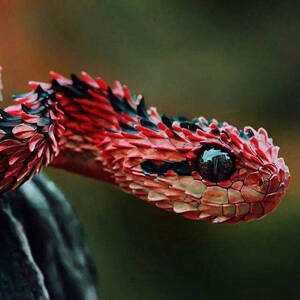Teratoscincus scincus
IUCN
LCBasic Information
Scientific classification
- name:Teratoscincus scincus
- Scientific Name:Teratoscincus scincus,Common Wonder Gecko,Frog-eyed gecko, large (small) species of fine-scale frog eyes, Kashiwa sand tiger
- Outline:Squamata
- Family:Gekkonidae Gekkonidae
Vital signs
- length:15-20cm
- Weight:No verification information
- lifetime:10-15years
Feature
It is a typical nocturnal gecko.
Distribution and Habitat
They are mostly distributed in the Middle East and southwestern Asia, from Turkmenistan, Iran and Afghanistan in the west to Xinjiang in China, and there are traces of their activities in the southwestern Arabian Peninsula.
In China, they are mainly distributed along the Ili River in Xinjiang and western Gansu.
Appearance
The body length can reach 15-20 cm, and the head-body length is about 80 mm, which is longer than the tail. The head is large, the nose tip is rounded, and the eye and ear openings are wide and oval. The diameter of the ear opening is 3/5 of the diameter of the eye, and the distance from the eye socket to the nose scale is equal to the length of the eye socket. The body is slightly fat, the hind legs are of medium length, the fingers are long, with claws, and the edges are horny. The head is covered with small granular scales, which are slightly wider on the nose and distributed on 25-35 scales between the eyes. The raised scales are quadrilateral, with notches on them, and the width is greater than the height. The nose is located between the raised scales and 3-4 nose scales. There are 9-10 upper and lower lip scales, and the chin scales are quadrilateral and slightly longer than the lip scales. The entire body is covered with scales arranged in a wide, round and smooth shingle patter
Details
Foreign name Common Wonder Gecko, no subspecies.

The Ili Sand Tiger lives in the desert and desert steppe areas on the edge of the oasis. Ili sand tigers are typical nocturnal geckos. They usually do not come out to move during the day. They often hide in the burrows they dug in advance, which are about 80 cm deep, and live in desert environments. At night, they often move among the bushes, and their movements are extremely sensitive and fast, and their skin is easily broken. They mainly feed on a variety of insects, including small lizards, spiders, insects and other small animals, and some plant foods.
Ili sand tigers are burrowing lizards, so they do not have enlarged toes that can be used for climbing like typical geckos. However, there are countless hard hairs around their toes, which will provide a good foundation for them to move on soft sand. Therefore, Ili sand tigers, which are not good at climbing, are skilled craftsmen in the soil. Ili sand tigers are very territorial geckos. If they are disturbed, they will raise their bodies and hiss. While they issue a stern warning, they are always ready to bite back. Another special feature of them is that they can slowly swing their tails like snakes, so that the large scales of the tails rub against each other and make sounds. The eyelids of both eyes have become keratinized, forming a cover that looks like a house eaves, which will replace the eyelashes to block the wind and sand. They are shy and timid by nature. When they encounter danger, they are agile and can avoid the enemy very quickly.
Ili sand tigers are oviparous. Females can lay 4-5 nests of eggs in a breeding season. Each nest lays about 2 connected eggs. A small number of them lay 1 egg. Under normal circumstances, the interval between nests is about 1 month. However, if one egg was laid last time, the interval between the next egg laying will be shorter, about 3 weeks. Each time, 1-2 eggs are laid, and the eggs can hatch into juveniles of about 60 mm after 75-95 days.

In 1993, Uzbekistan issued a stamp with the Ili Sand Tiger as the pattern.
Listed in the "Red List of Threatened Species of the World Conservation Union" (IUCN 2018 ver 3.1) - Least Concern (LC).
Listed in the "National List of Terrestrial Wildlife with Important Economic and Scientific Research Value" issued by the State Forestry Administration of China on August 1, 2000.
Listed in the second level of the "List of Wildlife under National Key Protection in China".
Protect wildlife and eliminate game.
Maintaining ecological balance is everyone's responsibility!








